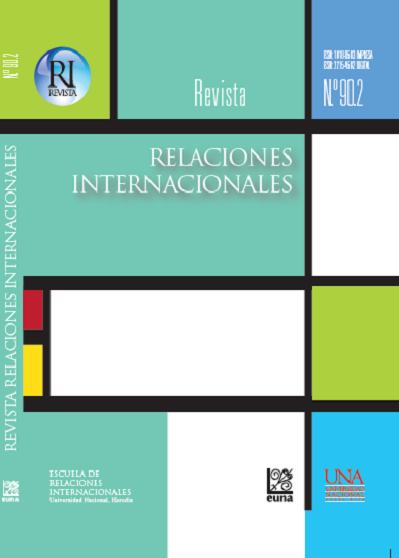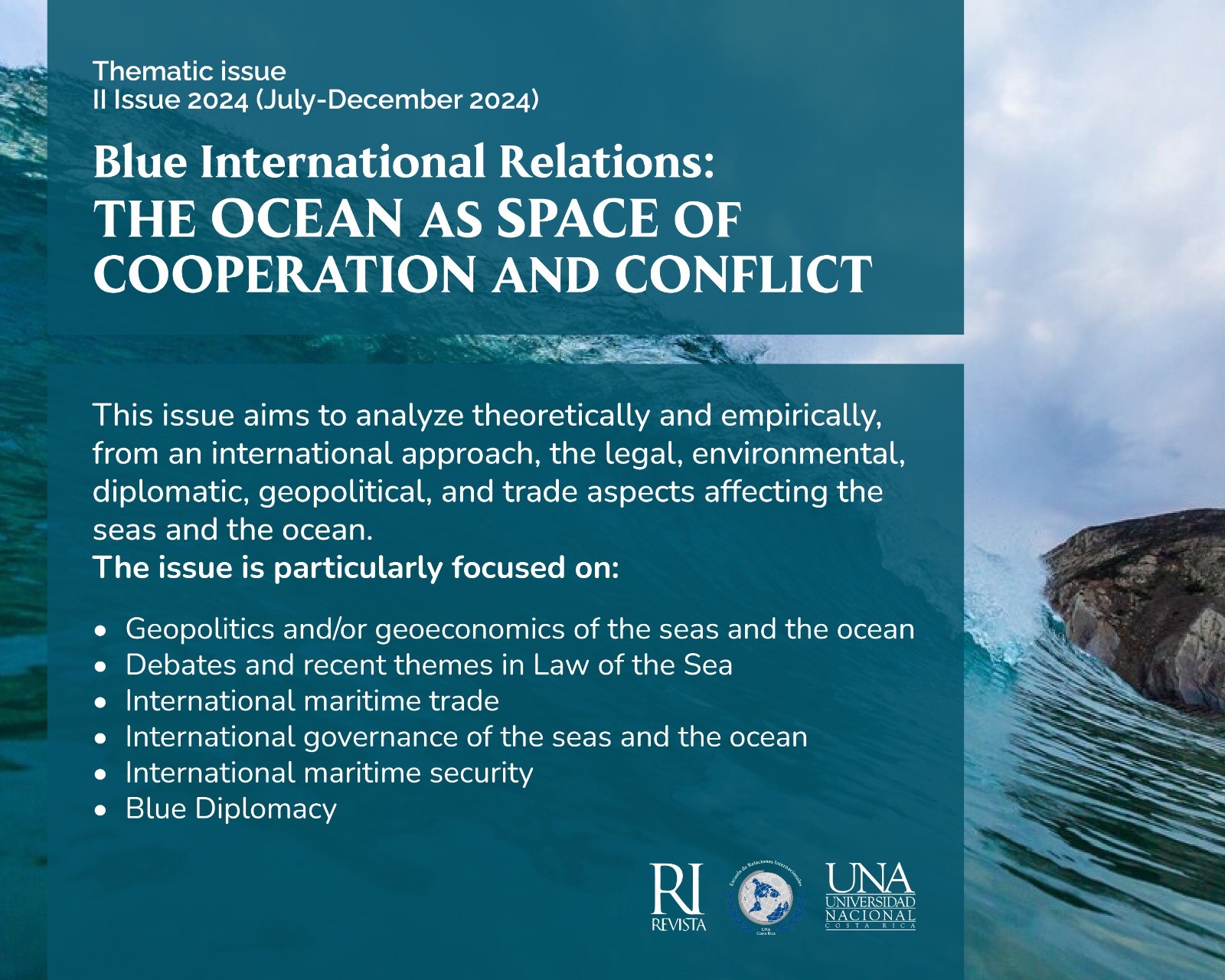CARIFTA TO CSME: From Free Zone to Economic and Political Union?
DOI:
https://doi.org/10.15359/ri.90-2.3Keywords:
Integración regional, solidaridad, asimetrías, CARICOM, CSME, Caribe.Abstract
Regional integration schemes strengthen links between member countries (closed regionalism) which are often neighbouring countries. At the same time, collaboration with other schemes can promote solidarity. Nevertheless, integration schemes are affected by asymmetries. The Caribbean Community (CARICOM) is a regional integration scheme which faces many challenges but has the potential to reach the same level of regional integration as the European Union. This article examines the evolution, challenges, asymmetries and opportunities of CARICOM and offers recommendations.
References
Atkins, Vincent J. (2000). Regional agricultural policy processes in the Caribbean Community. En Agricultural policy networking: the way forward (pp. 113-124)Wageningen: Technical Centre for Agricultural and Rural Cooperation (CTA). London: Sayce Publishing.
Barboza, Jorge. (2010). Procesos de unión económica y monetaria en Centroamérica. Ponencia Lanzamiento de la Revista de Derecho Comunitario, Internacional y Derechos Humanos. Universidad de Costa Rica, Costa Rica. Recuperado de http://www.derechocomunitario.ucr.ac.cr/index.php?option=com_content&view=article&id=116%3Aunion-economica-monetaria-cabarboza&catid=28%3A1&Itemid=27
Bown, Chad (2017). Mejores vecinos: Hacia una renovación de la integración económica en América Latina (Resumen). Washington, DC: Banco Mundial.
CARICOM. (2010). Tratado Revisado de Chaguaramas. Recuperado dehttp://www.caricom.org/jsp/community/revised_treaty-text.pdf
CEPAL. (2009-2010). Comercio e integración en el Caribe: Tendencias y perspectivas. En Panorama de la inserción internacional de América Latina y el Caribe 2009-2010: Crisis originada en el Centro y recuperación impulsada por las economías emergentes (pp.123-150) Recuperado de http://www.eclac.cl/publicaciones/xml/5/40695/Comercio_integracion_Caribe_tendencias_Capitulo_IV.pdf
Fontes, Max. (2000). Mercosul and Supranationality: How to Overcome Brazilian Constitutional Obstacles. Recuperado de http://www.hottopos.com/harvard4/max.htm
Girvan, Norman. (2005). Reinterpreting the Caribbean. In The Caribbean Economy: A Reader. Kingston: Ian Randle. (pp.1-17)
Girvan, Norman. (2009). The Caribbean Community encounters Global Europe Implications of Economic Partnership Agreements between CARIFORUM and EU. En Alfredo Guerra-Borges (Coord.), Fin de época: De la integración tradicional al regionalismo estratégico (pp. 352-381) México: Siglo Veintiuno Editores.
Gonzales, Anthony. (2002). CARICOM, the European Union and International Linkages in External Trade. Jean Monnet/Robert Schuman Paper Series, 2(4), 16. Recuperado de http://aei.pitt.edu/8082/1/gonzalesworkingpaper.pdf
Grenade, Wendy. (2011). Regionalism and sub regionalism in the Caribbean: Challenges and Prospects-Any insights from Europe? Jean Monnet/Robert Schuman Paper Series, 11(4), 25. Recuperado de http://aei.pitt.edu/33484/1/GrenadeCaribRegionalismLong2011edi.pdf
Griffith, Ivelaw. (2003). The Caribbean security scenario at the dawn of the 21st century: continuity, change, challenge. North- South Agenda Papers, 65.
Hornbeck, J. F. (2008). CARICOM: Challenges and Opportunities for Caribbean Economic integration. Congressional Regional Service Report for U.S. Congress: Recuperado de http://www.sice.oas.org/TPD/CAR_EU/Studies/CRSCARICOM_Challenges_e.pdf
La Rocque, Irwin. (2013). Regional Integration Process and Vision for the future of CARICOM. Recuperado de http://caricom.org/media-http://caricom.org/media-center/communications/speeches/distinguished-lecture-by-ambassador-irwin-larocque-secretary-general-caribb
López, Armando. (2000). La Comunidad del Caribe (CARICOM) en la encrucijada. Recuperado de https://www.nodo50.org/cubasigloXXI/economia/coll1_310503.pdf
Marín, Dunnia. (2013). El abordaje de las asimetrías estructurales en los esquemas de integración regional. Heredia, Costa Rica: Universidad de Gestión Editorial de la Escuela de Relaciones Internacionales.
Pimoljinda, Thanawat. (2010). Theoretical Discussion on Regional Integration: EU-ASEAN Perspective. Recuperado de http://www.academia.edu/388618/Theoretical_Discussion_on_Regional_Integration_EU-ASEAN_Perspective
Rocha Valencia, Alberto. (2001). La dimensión política de los procesos de integración regional y subregional de América Latina y el Caribe. En Jaime Preciado Coronado (Coord.), La integración política latinoamericana y caribeña: Un proyecto comunitario para el siglo XXI (pp. 165-212). México: Asociación por la Unidad de Nuestra América.
Secretaría Permanente del SELA. (2011). Las asimetrías en los procesos de integración en América Latina y el Caribe. Recuperado de http://www.sela.org/media/266783/t023600003433-0-tratamiento_de_las_asimetrias_en_los_procesos_de_integracion_en_alc.pdf
Stewart, Taimoon. (2000). Developing and Implementing a Competition Regime: Challenges Faced by Small Open Economies. Boletín latinoamericano de competencia, 11, 5. Recuperado de http://ec.europa.eu/competition/publications/blc/boletin_11_1_es.pdf
Thomas, Clive. (2008). CARICOM Perspectives on the CARIFORUM-EC, Economic Partnership Agreement. Recuperado de http://www.normangirvan.info/wp-content/uploads/2008/05/clive-thomas-caricom-perspective-on-the-cf-ec-epa-may-2008.pdf
Thomas, Graham y Esther Thomas. (2009). The Impact of Historical Excess on the Survival of the Caribbean Community and Common Market. Tamara Journal, 8(8.2), 11. Recuperado de https://tamarajournal.com/index.php/tamara/article/view/318/298
Downloads
Published
How to Cite
Issue
Section
License

Revista de Relaciones Internacionales por Universidad Nacional de Costa Rica está bajo una Licencia Creative Commons Atribución-NoComercial-SinDerivar 4.0 Internacional








1.png)







3.png)
